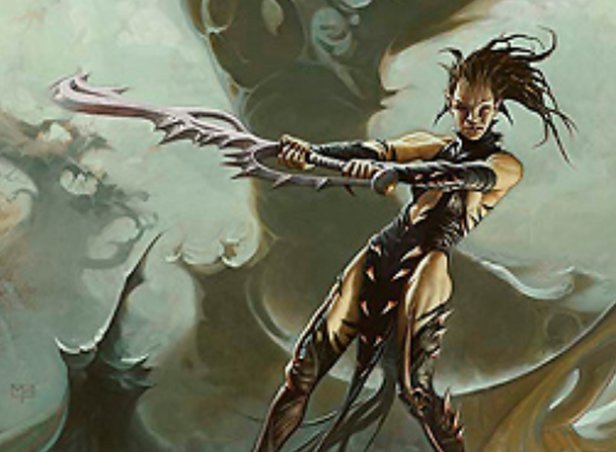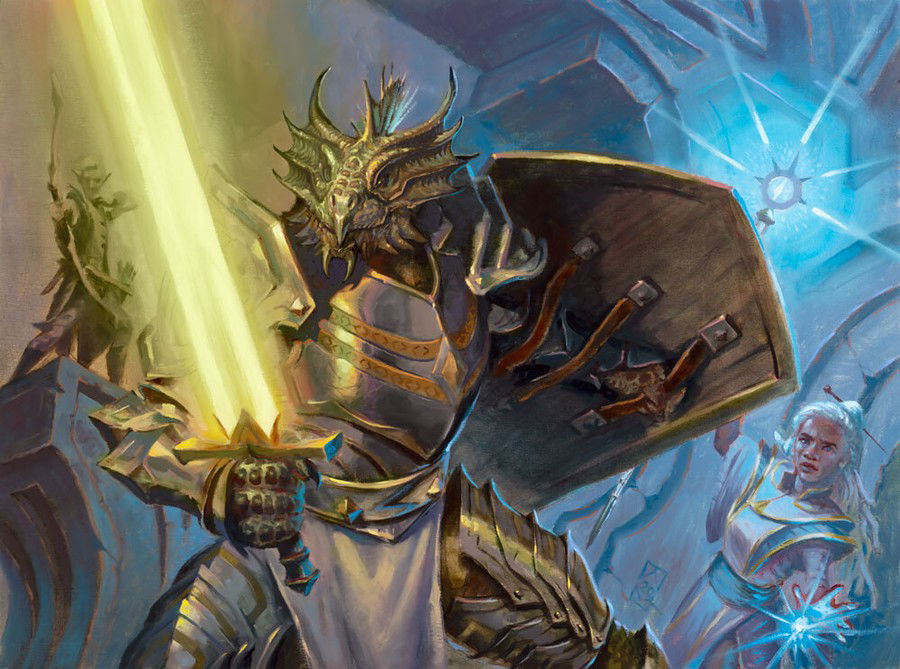We're back with another Deck Tech.
Let's be honest, Pauper is not at a good place right now: Storm and Affinity have become the main decks of the format by a significant margin.
Both decks together represent about 30% of the Pauper Metagame today, and few decks can compete and interact well with them because they are extremely resilient and the only decks that seem to have any success in the interaction plan are the Dimir Faeries and Dimir Delver decks.
The big problem with these decks is that it's not enough just to be disruptive to deal with them. Affinity manages to set a clock very fast and has inevitability in the form of Atog + Fling, while Storm needs to play against a board pressure or can wait as many turns as it takes to safely close its combo.
If you give too much time and/or spend too many resources responding to the opponent's stuff, Affinity will take advantage of that to re-build its hand and/or win with an Atog, and Storm will have enough time to create a setup to deal with whatever you have when going for the combo, and the big challenge against these decks is precisely to dose when you should be the proactive deck and when you need to keep your resources, so you don't lose on the next turn.
Therefore, a new category of decks has been highlighted in the last week as decks that can play well in this Metagame: the non-interactive decks.
That is, decks that only care about making your game plan faster than your opponent. It doesn't matter if your opponent is going to make multiple 4/4 or if they're going to put ten squirrels on the board, it's just that you can come up with a more efficient game plan before they can do it.
And it was based on this logic that player JherjamesB surprised all the other players, organizers and spectators of Pauper Masters Online, when he reached the Top 4 with a list that few players even take seriously since the banning of Invigorate : Infect!
The Deck
There is a popular saying among the Pauper Masters organizers that is "There is no bad match if you win in turn 2".
This saying was created by Leo (Bukareste) after the endless times I played the in-person events with lists that had as a strategy to win as quickly as possible, going through Inside Out, Infect, several variants of Kiln Fiend decks, etc.
But, in the case of JherjamesB, that's exactly what happened. In one of the matches, we saw the player win the event's champion, A_AdeptoTerra, winning both games in turn 2.
This past week, I've come to the conclusion that Pauper no longer has room for attrition-oriented games or value-based decks. The Metagame is prone to non-interactive games, quick games and where your goal is to go to the race and try to do your absurd thing before the opponent does their absurd thing.
The goal today in the format is not to be able to stop Storm and/or hold Affinity. You need to be faster than them, you need to be more explosive than them, you need to present a bigger threat than they present to you, and as unlikely as it sounds, this is the perfect Metagame for Infect because it's essentially the fastest deck in the format.
The deck's primary objective is to make the opponent gain 10 poison counters as soon as possible. Because of how Infect's ability works, pumps like Groundswell or Mutagenig Growth are essentially double what they would in other decks since the player has virtually 10 life.
The task seems easy, and because of the amount of low-cost spells that increase the deck's power, this can be done even on turn 2. However, Pauper is a format that, in a common metagame, is heavily geared toward creatures and interactions with creatures. Until the release of Modern Horizons II, the main keys to the format were attrition and card advantage, and Infect doesn't have as much space when absolutely every deck in the format will have the removals needed to handle your deck, as that means needing to create a setup beforehand which often won't be enough, especially against Black-Based or Tempo decks.
This doesn't mean that Infect can't play long games, it just has more difficulties in winning those games, as the opponent will always be planning to interact with it, which means it needs more resources and play more securely, looking to always take advantage of the smallest gaps that the opponent will use.
I talked to Jherjames about his deck and choosing it, and basically, his answer was that he expected a fast metagame that included a relevant amount of Storm decks, and he designed the deck to kill consistently between turns 2 and 4.
In addition, he designed the deck keeping in mind that the main removal of the format would be Galvanic Blast, so if he could play a creature on turn 1, Mutagenic Growth would commonly protect it from a Galvanic Blast of the opponent. Making his list, therefore, a great Meta Call that earned him the Top 4 of the Pauper Masters Online.
That said, let's go to the list:
Maindeck

Your threats.
What differentiates Infect from other decks with similar themes is the consistency in the number of creatures that perform the same type of effect in the deck's objective, which gives it an advantage compared to other decks like Kiln Fiend, for example.
In this method, Infect is more comparable to decks that have this same consistency in threats and/or effects such as Heroic or Burn. Essentially, your creatures in this deck are your Lava Spikes.
Glistener Elf is your primary threat and is the card you prefer, but is not required, to have in your hand, as it is the lowest-cost creature in the archetype. Most of your kills from turn 2 or 3 usually come from him, he is easier to protect than other creatures due to the low cost as well and is the card that will often, in the first turns, make the opponent regret to have kept a hand with lands that enters tapped or are not on the colors of your removals.
Ichorclaw Myr has two advantages in the archetype: the first is that it is a punishing creature to block because it grows with blockers, and that makes it the best carrier of Rancor in the deck. The second is that it's a colorless creature, so it escapes the effects of commonly used cards in the format, like Prismatic Strands.
Blight Mamba has the significant advantage of being a great creature in attrition matches against decks that use effects that allow it to regenerate, such as red removals or Cast Down. This also makes Blight Mamba a great creature for combat since, as long as you have mana available, it will never die and will always be weakening or destroying the opponent's creatures.
Finally, Cystbearer is an interesting option. This slot is commonly devoted to more ways to speed up the deck's clock or Rot Wolf as it will draw a card if a creature blocked by it dies. But since the deck's goal is to avoid validating the opponent's Galvanic Blast (and you can make a Cystbearer on turn 2 with Lotus Petal), the creature having 3 toughness makes a big difference, including in mid-game as well, as a Mutagenic Growth will leave you with 5 toughness instead of 4.

I'm categorizing both cards together because they have similar functions: securing your mana.
Lotus Petal helps make room for the deck's most explosive starts, often ensuring turn 2 or 3 kill plays with backup protection or speeding up an Ichorclaw Myr, or Blight Mamba in turn 1.
Quirion Ranger has several micro-functions in the deck: guarantee your land drops since the deck operates with 16 lands, untap your creatures if blocking is necessary, guarantee the Landfall trigger of Groundswell in any turn, and, finally, serving as a legal sacrifice target for cards like Chainer's Edict.

Your pump spells.
Your turn 2 or 3 kills commonly involve a mix of them, especially Groundswell which, for just one mana, can give +4/+4 to a creature, which for any creature in the deck is enough damage to give at least half of the poison counters needed to win the game.
Mutagenic Growth is a great free spell for the archetype, and it allows for an even wider range of possibilities in both your proactive and reactive plays. It's also the card your opponent must respect at all costs.
Rancor is the main form of evasion of the deck and is usually one of the cards that allows the deck to gradually add counters to the opponent, since you can focus on using your pumps and other resources to keep your creature alive and deal some damage, without necessarily needing to go after the combo-kill.

Your protection spells.
Vines of Vastwood can be used proactively at certain stages of the game to give +4/+4 to a creature, but the deck's common purpose is to try to keep it to protect your creature at the right time. After all, it's better to spend 1 mana and keep your threat on the board longer than spend 2 mana and lose your creature because you were too greedy.
Apostle’s Blessing has the function of, in addition to protecting your creatures against removals, to give them the necessary protection to make them unblockable against decks where the creatures tend to have a single color. This opens up more gaps for a combo-kill or to pull needed damage, when needed, to close the game.
Sideboard

There are games where you need more ways to gain reach and/or a blocker to hold back your opponent's initial aggression. Llanowar Augur serves both purposes, and is another card that can be sacrificed to cards like Chainer's Edict.

Faeries decks are still very present in the format and Spellstutter Sprite is a very problematic card for the archetype to deal with as it can, on its own, counter most of its spells and offer a blocker.
Therefore, Gut Shot is the best option the deck can have to deal against this deck without spending any other resources, while also allowing the deck to deal with Standard Bearer that, despite not seeing as much game currently, it's one of the most problematic cards for this kind of strategy to deal with.

You can't just hope to be able to protect all your creatures and dodge all removals. And Hunger of the Howlpack is therefore a great way to take advantage of your creatures dying throughout the game, giving the deck an element of resilience and attrition by making your creatures permanently out of the zone of some removals and making them efficiently attack/block smaller creatures.

With the rise of Burn in recent weeks as a viable strategy to deal with the current Metagame, and being a deck that barely recovers if the opponent uses the first spells as removals, it is necessary to buy time to recover and Life Goes On is a cheap and efficient answer to that issue.
Analysis
The first thing I think it's important to mention is that, although I've categorized the cards as pumps and protection spells, it's almost a disservice to consider them solely for one or the other purpose throughout the game.
Infect needs creatures to function. Everything else in the deck is completely useless if you don't have at least one creature on the board that you need to present as a constant threat to your opponent. Therefore, the use of your spells needs to be conscious and keep pace with the game.
Of course, you can always take the opportunity given by your opponent and try to deal the lethal damage, especially if you have the necessary answers to whatever means the opponent might have to interact with you, but if your damage is not enough, there's no point trying to rush things, and it's often better to only deal 1 damage than deal 7 and not being able to protect your creature or push the rest of the damage later.
Because of this, every spell used in Infect also counts as a protection spell, and this is essential for interactive matches and is something that players should consider.
On the other hand, it's important to know when to try to seize the opportunities. A prolonged game against Faeries will often mean not getting enough damage because the deck has many cards that are commonly good against you and many ways to filter their draws.
Therefore, Infect is a much more complex deck to pilot than you might think, as your perfect 2 or 3 turn hands come a lot less often than you would normally like, as you need a 4-card set. + lands, plus the deck doesn't interact well; therefore, often your option throughout the game is to plan ahead and sequence your plays to take advantage of each gap left by the opponent without getting carried away by the impulse that can often finish with your creatures dying before dealing damage.
Another point to consider in your matches is that damage dealt by a creature with Infect is dealt in the form of -1/-1 counters. This is relevant in the current Metagame because a creature with Infect with the right pump spells can serve to weaken the opponent's attackers, permanently kill cards like Atog or creatures with Persist, and prevent the opponent from regenerating their creatures.
Due to the lack of interaction Infect is a great meta call for the format today, the hate spells commonly used to deal with the main decks of the format are not enough to stop Infect and/or are irrelevant in most occasions and are cards easy to play around.
When a banlist comes out, it will be time to analyze how the format will develop. If we go back to the era where the format is geared towards creatures, removals and value, Infect will have its main Achilles heel back, which is a higher amount of targeted removals on the lists, in addition to the return of the Edicts effects that are so problematic for the deck as they are usually for other decks of the same style, such as Heroic.
Until then, if you want to prey on the non-interactive decks of the format without necessarily being hated-out by cards like Weather the Storm
and you like lists that aren't on the Metagame's radar today, Infect is your best choice.
Conclusion
And here we close the Pauper Infect Deck Tech.
The format is currently in a broken state and I honestly hope that direct intervention takes place soon. It's been a month and the format hasn't adapted, it's polarized with two decks making up more than 30% of the Metagame.
I might like this explosive format and with a higher power level than usual like what we currently see in Pauper, but when it comes to two decks being superior to the rest, there's a chronic problem with the diversity, and it starts to fall apart and becomes uninteresting, losing players and damaging every Pauper event that might exist.
After all, nobody likes to play in a Metagame where you have to choose a specific deck, or you will be playing wrong. And each week, this is the format Pauper seems to be becoming.
Until the banned and restricted announcement, however, if you prefer not to play one of the two obvious best decks in the format and also want to stay off the radar of the other decks, count to ten, attack with Glistener Elf and win the game before they have a chance to start their game seems like a viable option.
Thanks for reading!














— 评论 0
, 反应 1
成为第一个发表评论的人